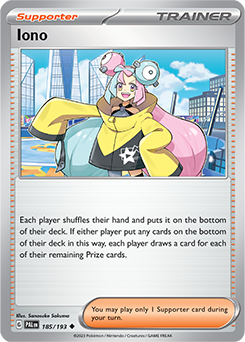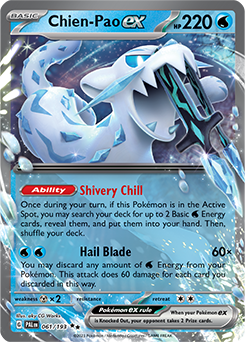Paldea Evolved Format Starter Pack: My Top 10 Decks
Hello all PokeBeach readers! Here is Gabriel again with another Pokémon TCG article, and this time, I’m going to list my top ten decks of the Paldea Evolved format.
Every format starts with people wondering which decks got better, which decks got worse (because of the changing metagame), and which new decks can emerge thanks to new cards or concepts that arrive with the new set.

In Paldea Evolved, we have two cards in particular that affect practically all decks in the format: Iono and Super Rod. Throughout this article, you will notice that I advocate for practically all of my top ten decks to play Iono and Super Rod. Thanks to these cards, the lists gain freedom to invest in other cards. Sometimes, two simple cards are enough to bring a big change to a format. A Gardevoir ex deck with these two cards is much better than a Gardevoir ex deck without them, and the deck’s recent results are a reflection of that.
Only one new deck appears in my top ten, Chien-Pao ex / Baxcalibur, which, despite having great potential and fun gameplay, still has some bad points that prevent it from being part of the format’s top three. Lugia VSTAR got a new variant, which is potentially better than the Single Strike version. In today’s article, you can check out my first analysis of the best decks in the format, with my predictions of which decks will stand out the most in the upcoming North America International Championships and World Championships.
10) Fusion Strike Mew VMAX
New inclusions:
- +1 Iono
- +1 Eiscue
The Fusion Strike variant of Mew VMAX — which goes heavy on Fusion Strike Pokémon like Meloetta and Oricorio, as opposed to the Path to the Peak–focused variant I’ll discuss later in this article — just won the most important tournament in Japan. It only barely makes my top ten, though, and that’s because of the metagame. Here in Latin America, Fusion Strike Mew VMAX was one of the biggest flops of the Santiago Regionals in Chile. (On the other hand, though, Gardevoir ex was one of the main decks, whereas in North America it is not very successful at all.)
Leaving aside the metagame factor, what I don’t like about Fusion Strike Mew VMAX is that it tries for strong power plays, but doesn’t always succeed because of the deck’s inherent issues with resource management. All the cards in the deck come in sufficient counts, but due to the aggressive draw engine, which forces you to discard cards from your hand in order to develop your setup, you might miss out on some important resources in the late game.
Compared to Mew VMAX / Path to the Peak, this version is worse against Drapion V and has worse consistency overall. However, it is undeniably a stronger version, with more attack options and a better chance against Spiritomb.
Speaking of Spiritomb, the main reason we play Eiscue now is so we can Knock Out opposing Spiritomb as soon as possible. It also helps Knock Out Ralts and Kirlia before they have a chance to evolve, which can be devastating on a turn where you also play Judge or Iono. It is true that the opponent can play Manaphy to guard against Eiscue, but if they do, you just don’t play Eiscue and continue playing the deck as normal. Forcing them to cede a Bench spot to a useless Pokémon is already a small advantage.
9) Lost Hisuian Goodra VSTAR
New inclusions:
- +2 Spiritomb
- +1 Super Rod
- +1 Jet Energy
There are many great examples of metagame differences between regions. The success of Mew Fusion in Japan and the success of Mew Path elsewhere is a great example. The difference that stands out to me the most, though, is the fact that Lost Giratina VSTAR is one of Japan’s greatest hits, while it has rarely seen any play at all over here. Instead, the Pokémon that succeeds in a similar deck is Hisuian Goodra VSTAR. From my understanding, the main reason for this is that Lost Box / Dragonite V is one of the highest-performing decks here, and one of the most popular as well, and it’s not a good matchup for Lost Giratina. Goodra, on the other hand, does well against any variant of Lost Box.
Goodra VSTAR should do well in this format like it has done before, not only because of its natural advantage against Lost Box decks, but also because it’s just really good. Goodra VSTAR is strong enough to take on the metagame’s main threats, including Gardevoir ex and Lugia VSTAR, and it has most of the advantages of a traditional Lost Box deck, such as attacking with Cramorant for free, Mirage Gate‘s Energy acceleration, and Radiant Greninja for consistency and powerful Bench damage.
In Paldea Evolved, there aren’t too many cards that improve the deck, so the strategy and list remain very similar to the previous format. Super Rod is a better card than the awkward combo of Energy Recycler and Klara, as your main priority is setting up two Goodra VSTAR, so you don’t need to worry so much about recovering large numbers of Pokémon and Energy cards.
Another change I’m testing is two Spiritomb instead of Drapion V to deal with Mew VMAX. The advantage of this is never starting with Drapion V (which can often lose you the game) and being able to start with Spiritomb instead, a single-Prize Pokémon which retreats for only one Energy (which becomes free with Beach Court). And, to be honest, even with Drapion V, it’s hard to beat a well-played Mew VMAX deck. The ideal thing would be to play two copies of Drapion V, which is almost untenable for Goodra VSTAR, a deck that aims to withstand attacks and avoid offering easy Prizes.
Another matchup in which Spiritomb can be an asset is against Lugia VSTAR, especially the new variant focused on Snorlax and Wyrdeer V. This is because Spiritomb prevents Lumineon V from using its Ability, which helps keep the opponent from playing a Professor Burnet on the first or second turn. Also, Wyrdeer V will find it hard to muster the Energy needed to KO a Hisuian Goodra VSTAR.
Jet Energy is an obvious addition to the deck, even in Goodra VSTAR, which has historically liked V Guard Energy to further increase its defensive power. Most of the time, you don’t need V Guard, and Jet Energy is always welcome to help with consistency. Even when you already have Goodra VSTAR in the Active Spot, you still want to draw cards with Comfey, and for that, Jet is perfect.
I don’t like Iono or Roxanne in Goodra VSTAR, as I believe that after setting up with Colress's Experiment and Melony, you just want to use Boss's Orders to draw your six Prizes as quickly as possible. (Even Goodra VSTAR’s defensive power has limits!) Moreover, it is not a guarantee that your Iono or Roxanne will even work on the opponent, especially since they may be running Bibarel, Kirlia, or Genesect V. The format in general is prepared to withstand effects like this.
8) Chien-Pao ex / Baxcalibur

This deck is the big news from Paldea Evolved, but unlike past new-set highlights like Gardevoir ex and Lugia VSTAR, this deck doesn’t arrive with the quite the same level of hype. The list requires three Evolution lines to work: Baxcalibur to accelerate Energy from hand; Bibarel to draw cards; and Origin Forme Palkia VSTAR to recover Energy from the discard pile. Chien-Pao ex, the star of the deck, is in charge of fetching Energy from the deck and dealing damage. Everything might seem perfect in theory, but when you put the whole strategy into practice, you probably already more or less have an idea of what will happen. There’s always something that goes wrong.
Stage 2 decks are always a problem unless they have some special help with their consistency. Irida provides this for Baxcalibur because it searches easily for a Rare Candy and a Water Pokémon, so the deck needs four copies for the best odds of getting a turn-two Baxcalibur. Then, you still need to focus on setting up Bibarel and Palkia VSTAR, so your opponent doesn’t just target your Baxcalibur and leave you without a board. Palkia VSTAR is your main attacker most of the time, and Chien-Pao ex generally only comes in when you need to deal more than 280 damage.
The setup is a little complex, but the deck in theory has the consistency it needs. The main issue is that the opponent will do everything they can to hinder you, and that’s where the deck really suffers. Even if you manage to bring Baxcalibur, Bibarel, Palkia VSTAR and Radiant Greninja to the field, the opponent will usually be able to Knock Out the most integral piece in your game plan. If you’re low on cards, for example, they’ll Knock Out Bibarel. If you’re out of Stadiums, they’ll play a Path to the Peak and Knock Out Baxcalibur.
I really like Chien-Pao ex’s Ability and I believe it adds a lot to the consistency of any Water deck. Take two Water Energy from the deck, draw two cards with Radiant Greninja, and always have your attachment for the turn. However, the attack, while strong, is unnecessary most of the time. You don’t really need to hit 300-360 damage that often.
At the end of the day, it’s just too unreliable a deck to be among the best.
This concludes the public portion of this article.
If you'd like to continue reading, consider purchasing a PokeBeach premium membership! If you're not completely satisfied with your membership, you can request a full refund within 30 days.
Each week we post high-quality content from some of the game's top players. Our article program isn't a corporate operation, advertising front, or for-profit business. We set our prices so that we can pay the game's top players to write the best content for our subscribers. Each article topic is carefully selected, goes through multiple drafts, and is touched up by our editors. We take great pride in our program!

